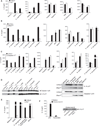TRIF licenses caspase-11-dependent NLRP3 inflammasome activation by gram-negative bacteria
- PMID: 22819539
- PMCID: PMC3660860
- DOI: 10.1016/j.cell.2012.07.007
TRIF licenses caspase-11-dependent NLRP3 inflammasome activation by gram-negative bacteria
Abstract
Systemic infections with Gram-negative bacteria are characterized by high mortality rates due to the "sepsis syndrome," a widespread and uncontrolled inflammatory response. Though it is well recognized that the immune response during Gram-negative bacterial infection is initiated after the recognition of endotoxin by Toll-like receptor 4, the molecular mechanisms underlying the detrimental inflammatory response during Gram-negative bacteremia remain poorly defined. Here, we identify a TRIF pathway that licenses NLRP3 inflammasome activation by all Gram-negative bacteria. By engaging TRIF, Gram-negative bacteria activate caspase-11. TRIF activates caspase-11 via type I IFN signaling, an event that is both necessary and sufficient for caspase-11 induction and autoactivation. Caspase-11 subsequently synergizes with the assembled NLRP3 inflammasome to regulate caspase-1 activation and leads to caspase-1-independent cell death. These events occur specifically during infection with Gram-negative, but not Gram-positive, bacteria. The identification of TRIF as a regulator of caspase-11 underscores the importance of TLRs as master regulators of inflammasomes during Gram-negative bacterial infection.
Copyright © 2012 Elsevier Inc. All rights reserved.
Figures






Comment in
-
Host response: Connecting the dots in inflammasome activation.Nat Rev Microbiol. 2012 Sep;10(9):596-7. doi: 10.1038/nrmicro2866. Epub 2012 Aug 13. Nat Rev Microbiol. 2012. PMID: 22886236 No abstract available.
References
-
- Cusson-Hermance N, Khurana S, Lee TH, Fitzgerald KA, Kelliher MA. Rip1 mediates the Trif-dependent toll-like receptor 3- and 4-induced NF-kappaB activation but does not contribute to interferon regulatory factor 3 activation. J. Biol. Chem. 2005;280:36560–36566. - PubMed
-
- Duncan JA, Gao X, Huang MT, O’Connor BP, Thomas CE, Willingham SB, Bergstralh DT, Jarvis GA, Sparling PF, Ting JP. Neisseria gonorrhoeae activates the proteinase cathepsin B to mediate the signaling activities of the NLRP3 and ASC-containing inflammasome. J. Immunol. 2009;182:6460–6469. - PMC - PubMed
Publication types
MeSH terms
Substances
Grants and funding
LinkOut - more resources
Full Text Sources
Other Literature Sources
Molecular Biology Databases

